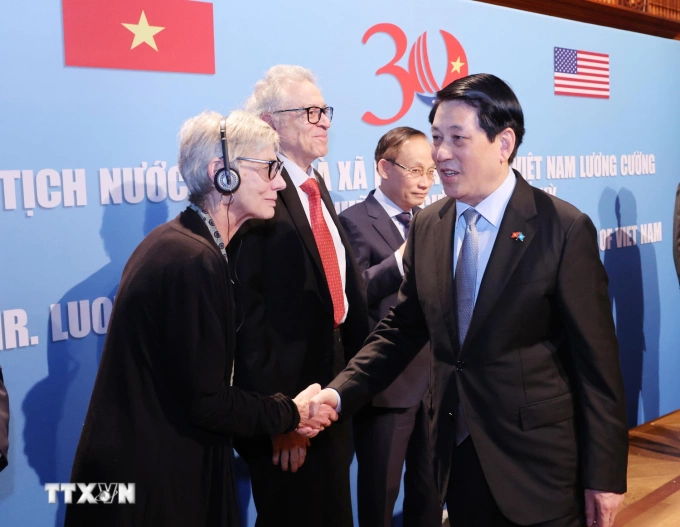“The Participation of the Fund for
Reconciliation and Development (FRD) in the Normalization Process” - Mr.
John McAuliff, Executive Director of the Fund for Reconciliation and Development
(online)
(i) Clarify the key
highlights and major features of Vietnam–U.S. people-to-people relations over
the past 30 years; identify the differences between Vietnam–U.S.
people-to-people relations during the 1995–2025 period and those in the periods
before 1975 and from 1975 to 1995.
Steps toward normalization:
1)
191965-1975
A small but influential sector of
the antiwar movement became directly involved with Vietnamese from the DRV and
the National Liberation Front at meetings in Canada, Bratislava, Paris and Stockholm. During
the war approximately 200 activists and significant cultural figures visited Ha
Noi and connected with NLF linked students and Third Force leaders in
Saigon. These relationships led to the
creation of the Peoples Peace Treaty in 1971 and a campaign for its adoption
throughout the US. Much of the antiwar
movement was cautious about too close an association with the “other side” because
it might be considered disloyal. Broader
public opinion was uncomfortable with NLF flags in protests.
1975-1985 A delegation of activists from the Indochina Peace Campaign and the American Friends Service Committee (AFSC), including myself, arrived in Ha Noi the day the war ended, remaining for two weeks. Quaker and Mennonite staff posted to Saigon stayed there for some months after liberation. Most organizations and activists that had been involved in the broad movement against the war greeted April 30th with feelings of achievement and relief and went on to other concerns like nuclear weapons and Central America.
1985-1995 Wider sectors of US and Vietnamese society became engaged with each other creating the foundation for normalization. The US-Indochina Reconciliation Project of the Fund for Reconciliation and Development, our organization, began in 1985 organizing twice a year delegations that introduced professors, academic institutions and foundations that followed up their own programs of cooperation. The delegations were hosted first by the Ministry of Foreign Affairs, then by Vietnam Tourism, and finally by the Viet Nam USA Society.
FRD coordinated ten conferences between 1989 and 2001 in partnership with the Viet Nam Union of Friendship Organizations that brought US NGOs together with counterparts from Viet Nam, Laos and Cambodia leading to many new collaborative programs. The goal was both to provide assistance and to foster normal relations. By 1994 210 international NGOs, largely American, had authorized programs in Vietnam registered with PACCOM, sometimes with in-country staff. Veterans created a variety of binational programs in literature, the arts and humanitarian assistance. Mainstream US academic institutions established research and training projects. The business community’s interest and support took institutional form with the launching of the US-Vietnam Trade Council in 1989. A growing number of US sponsored Vietnamese expert delegations visited the US and regional countries.
An agreement negotiated by General John Vessey and Foreign Minister Nguyen Co Thach in August 1987 took reconciliation to a governmental level as each side acknowledged the other’s humanitarian needs; humanitarian assistance was officially encouraged from new American private sources. US Senators who were veterans played a higher level role, enabling Fulbright scholarships in 1992, overcoming myths of living POWs, and creating the political environment for President Clinton to end the embargo and normalize relations.
(ii) Identify the current contextual factors that affect
Vietnam–U.S. people-to-people relations, including both favorable conditions
and challenges.
1)
The objective interests of the two countries and
their economic institutions provide an important motive for people-to-people relations. The goal of the US to contain China,
especially in the East Sea, coincides strategically with Viet Nam’s concern for
its independence and sovereignty.
Methods of achieving these ends may have tactical differences, including
links to the more volatile China-Philippines conflict. Family
relationships are an enduring bond, regardless of reasons and timing of
emigration. Marriages between Americans and
Vietnamese are building new lifelong ties.
The US will have difficulty understanding how Viet Nam can seem to have warm Party to Party and ideological bonds with China at the same time that there is open conflict over territorial control. Our countries also have very different visions of human rights and democracy. In the current context, the US sets these differences aside. However, it is also possible that liberal or conservative self-righteousness and regime change arrogance can reemerge. The unpredictability of the current US Administration creates additional challenges in both countries.
(iii) Determine the partners, content, formats, and measures
to promote Vietnam–U.S. people-to-people exchanges in the current period.
I see four potential areas for VUS/VUFO engagement
1) 1) Continue to work with the diminishing number of
Viet Nam war era activists and veterans to connect or reconnect their personal
histories with Vietnamese war legacies and current reality.
4) 4) Over the next ten years create sister city
partnerships between every Vietnamese province and US state. These can become vehicles for many levels of
long term relationships with visits and social friendships and collaborations
professionally, culturally and economically.
High school and college level student exchanges should be facilitated
and perhaps even subsidized and involve local hosts in both countries.

